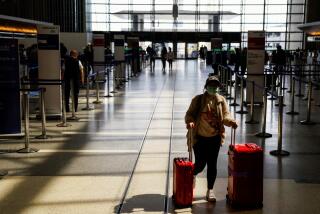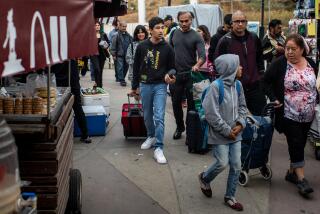Deported Nazi Tries to Reenter U.S.
A documented Nazi war criminal who arrived at Los Angeles International Airport last weekend, apparently seeking to enter the United States, was instead put back on a plane to Australia, where he holds citizenship, authorities said Thursday.
Konrads Kalejs, 84, whom a U.S. appeals court once labeled a âkey officerâ in the killings of tens of thousands of Latvian Jews during World War II, told immigration agents when he arrived at the airport Saturday that he was only passing through from Australia en route to Mexico.
U.S. authorities, however, suspected that he wanted to go to Mexico so that he could sneak across the border to the United States, where he lived for nearly 35 years before being deported in 1994.
Kalejs was identified at the airport from a little-known âwatch listâ of suspected or documented Nazis and collaborators. That list, which contains about 70,000 names, is compiled by an agency familiar to only a few--the U.S. Justice Departmentâs Office of Special Investigations, which probes war crimes allegations involving the Nazis and their allies.
The agency shares the list with the Immigration and Naturalization Service. Typically, prompted by alert INS agents, the Office of Special Investigations gets one call each week about suspected former Nazis--or those with ties to the former Third Reich--trying to enter the United States, said Eli M. Rosenbaum, its director.
The 70,000 names on the list are those suspected of involvement in âAxis acts of persecution,â the legal standard for exclusion from the United States. Computer technology has given agents the ability to quickly check the names of passengers on incoming flights against the âwatch listâ and other lists.
âPeople would be amazed to learn whatâs happening at U.S. airports,â Rosenbaum said. âWeâre talking about a weekly phenomenon.
âMost of these people are [former] SS,â he said, referring to the notorious Nazi special police. âIf they deny having been in the SS, we instruct the INS agent at the scene to instruct the individual to ask him to take off his shirt--itâs always men--and allow the agent to look under the left bicep. Weâre looking for the telltale blood-type tattoo the SS gave to most of its men.
âCan you imagine,â he said, âitâs 52 years after the war and this is going on at all our major airports?â
Equally difficult to imagine, he said, was Kalejsâ appearance at a U.S. airport--for American authorities had fought a long and protracted battle to deport him. Although not an SS officer, Kalejs âwas involved in some of the most gruesome crimes of the Holocaust,â Rosenbaum said Thursday.
Some experts on the Holocaust said they too were stunned to learn of Kalejsâ brief appearance at the airport. He was detained for about 12 hours, then forced--at his own expense--to board the Australian-bound jet, Rosenbaum said.
âThe tragedy of all of this is that when people read about this, some people will think, âOh, heâs an old man,â â said Rabbi Marvin Hier, dean and founder of the Simon Wiesenthal Center in Los Angeles. â âWhy donât they let him be?â
âWeâre talking,â Hier said, âabout a mass murderer who has never faced the bar of justice for the crimes he committed.â
Kalejs has repeatedly denied involvement with Nazi-sponsored death squads. He has maintained that he was a university student or farm laborer during World War II.
But according to a 1993 opinion from the Chicago-based U.S. 7th Circuit Court of Appeals, he was a company commander in a pro-Nazi unit that killed thousands of Latvian Jews and took part in other persecutions at the brutal Salaspils labor camp.
That unit was formally known as the Latvian Auxiliary Security Police. Informally, it was called the Arajs Kommando, after its leader, Viktors Arajs, who was convicted by a German court and sentenced to life imprisonment in 1979 for complicity in the deaths of thousands of Jews. Arajs died in prison.
Kalejs, meanwhile, moved to Australia after Germanyâs defeat. He became a citizen there.
In 1959, he entered the United States. On his entry application he said he had been a farm laborer during the war.
From 1959 to 1984, he lived in the United States, becoming a financial success with several homes and assets in the millions.
In 1984, as the Justice Department was closing in on him, he took $350,000 in cash and fled to Canada and Australia, the 7th Circuit court said.
When Kalejs returned to the United States, he tried to assume a new identity and managed to elude capture for six months, the court said.
He was arrested in Florida in April 1985--launching a lengthy court fight that ended with his April 8, 1994, deportation to Australia.
Later that year, according to Rosenbaum, Kalejs was discovered near Toronto.
After a series of court battles in Canadian courts, he was deported from that country in August 1997, Rosenbaum said.
On Saturday morning, Kalejs appeared in Los Angeles, arriving via a United Airlines flight from Melbourne. INS agents were waiting for him because his name was on the passenger list.
In the transit lounge for international flights, a source said, Kalejs âtried to get awayâ from INS agents.
With nowhere for him to escape, however, agents detained Kalejs and conferred with an Office of Special Investigations staffer at home in the Washington suburbs.
Kalejs then told authorities he was merely connecting at the airport to a Mexico-bound flight.
INS agents, however, put him on a United flight back to Melbourne that night.
Even if he had in fact been bound for Mexico, Rosenbaum said, âone suspects he wanted be near the United States because itâs not terrifically difficult to cross from Mexico. Itâs easier to do it from Canada--but he canât go to Canada anymore.â
More to Read
Sign up for Essential California
The most important California stories and recommendations in your inbox every morning.
You may occasionally receive promotional content from the Los Angeles Times.










